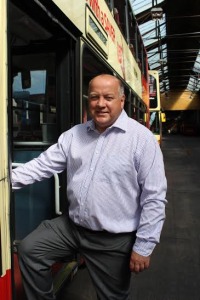At least 17 buses are to be refitted to cut their harmful emissions, partly funded by £250,000 from the government and Brighton and Hove City Council.
The latest retrofit project comes after 73 double-decker buses were given a similar revamp from 2014 to 2017 as air quality continues to breach legal limits in some parts of the area.
And Brighton and Hove Buses spent £17.8 million on 54 buses which, the council said, “run on zero emissions through the city centre.”
The council added: “These newly converted buses travel through the city’s Air Quality Management Areas (AQMAs).
“These are designated areas, including several city transport corridors, where the council has committed to better than compliant air quality and a healthier environment for all.
“Among others, the new retrofitted buses will service routes 28 and 29 on the A270 Lewes Road and London Road, which link the city’s universities with the city centre.
“The retrofitting is scheduled to be done before next winter.”
The government awarded £149,500 to the council after a bid to the Air Quality Grant scheme while £99,500 will come from the council’s own Sustainability and Carbon Investment Fund, with a significant contribution from Brighton and Hove Buses.
The council said: “Retrofitting the exhausts of the most frequent older buses, registered eight to ten years ago, will convert them from Euro-V to substantially cleaner Euro-VI emission standards that cut greenhouse gas nitrous oxide, the reactive nitrogen monoxide and the harmful nitrogen dioxide.
“To avoid carbon to atmosphere, we want to avoid scrapping vehicles prematurely.
“The retrofits are a resourceful way of utilising existing bus assets, not yet nearing end of life.
“When the time comes to replace vehicles, we will want this to be with zero emission technology.
“Air pollution is the greatest environmental risk to human health. The quality of air we breathe affects everyone, including non-smokers, the old and young. Roadside pollution has disproportionate impacts and is a source of inequalities.”

Green councillor Amy Heley, who chairs the council’s Environment, Transport and Sustainability Committee, said: “This really is very good news and I’d like to thank officers for their hard work in their successful bid which I understand was rated very highly.
“We have a very good bus network in the city and we’ve seen passenger numbers continue to grow.
“Cleaner low-emission buses mean we can provide our residents and visitors with sustainable travel options and continue to improve our air quality.”

Labour councillor Gary Wilkinson, who speaks for the opposition on the committee, said: “It’s great to see that more of our buses will be meeting higher emission standards in the future.
“We have excellent passenger numbers in Brighton and Hove. People can make their journeys safe in the knowledge we’re doing more to make it a sustainable and low-emission option.
“Better air quality is something that benefits all our residents, visitors and businesses.”

Brighton and Hove Buses managing director Martin Harris said: “This is really good news in what has been a challenging year for public transport.
“This funding allows us to continue to work towards our shared goal of improving air quality and tackling climate change.
“It’s great that the people who live, work and study along the Lewes Road and London Road will benefit from this funding.”








Great that according to the article this retro-fit will help NOx emissions, especially as the worst area in the city is by the Clock Tower where all bus routes converge and there are few private vehicles.
However, this will do nothing for CO2 emissions which I thought we were trying to address.
I would have thought that if our environmental experts Green Amy Heley and her tame Labour “opposition” puppet Gary Wilkinson should understand this.
Peter Challis said: “However, this will do nothing for CO2 emissions which I thought we were trying to address.”
A large vehicle like a bus has a huge embodied CO2 footprint from its manufacture. If the CO2 emissions that will be generated by scrapping and recycling the materials used in these buses and manufacturing and running new ‘zero emission’ buses to replace them with is more than the CO2 emissions from the buses exhaust for it’s remaining life, then it’s actually greener to keep the old buses running and retro-fit them to comply with Euro 6 regulations.
Seeing as the current crop of ‘zero emissions’ buses are simply extended range hybrids, which over an entire route will chuck out only slightly lower levels of CO2 than a conventional bus (as the batteries used in the low emissions zones have to be recharged from the buses diesel engine), this is probably the best option for both the bus company and the environment until the technology for pure EV battery buses becomes economically viable and widely available.
Thanks Dave – agree with comments about carbon footprint of new builds, but B&H buses have committed to switching to Hydrogen by 2030 so this is only an interim action before they either get scrapped or used elsewhere.
In addition I would love to see data to support the claim that these hybrids have lower overall carbon emissions, as they have to carry the additional load of batteries at all times. I know they have regenerative braking, but what is the real answer.
Also for completeness, the “zero emission hybrid buses” that B&H Buses are so proud of, still produce CO2 outside the ULEZ as they charge the batteries, and nothing has been released about the effect on total CO2 for journeys, as this is what impacts global levels and the climate emergency.
For buses to be truly zero emission we need either battery, hydrogen or ammonia energy sources.
“Labour councillor Gary Wilkinson, who speaks for the opposition on the committee”
Wrong. Labour is not the opposition but the Greens’ patsy.
He speaks for Labour Momentum who keep the Greens in power.